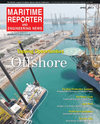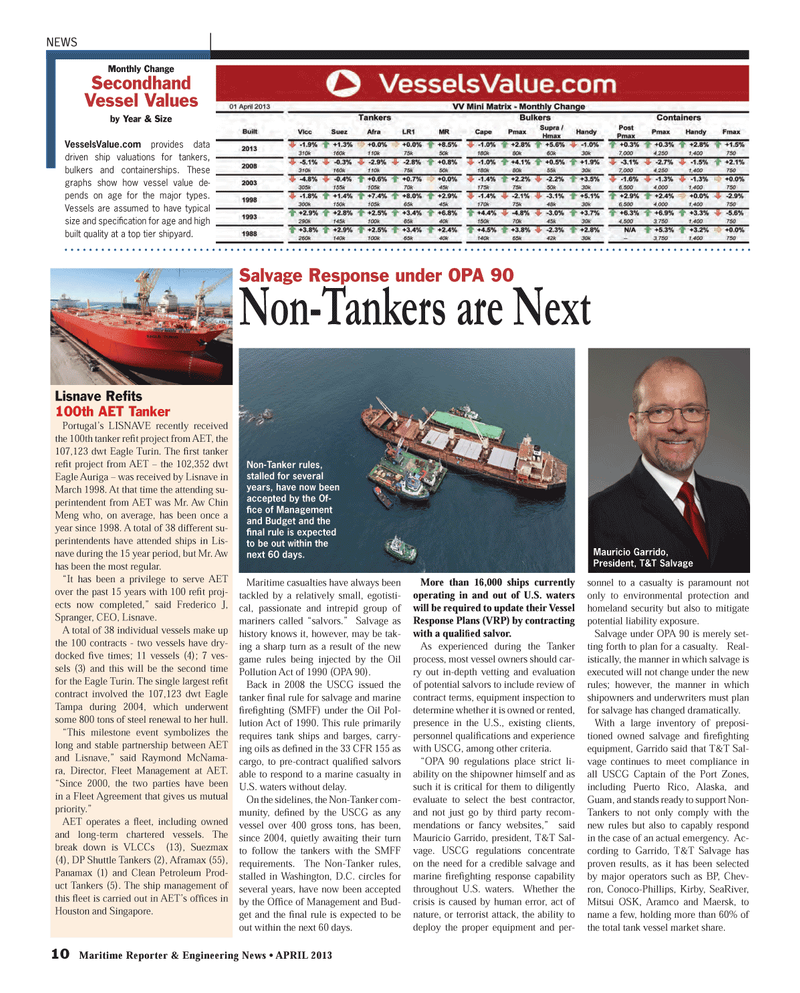
Page 10: of Maritime Reporter Magazine (April 2013)
Offshore Energy Edition
Read this page in Pdf, Flash or Html5 edition of April 2013 Maritime Reporter Magazine
Maritime casualties have always been tackled by a relatively small, egotisti-cal, passionate and intrepid group of mariners called ?salvors.? Salvage as history knows it, however, may be tak- ing a sharp turn as a result of the new game rules being injected by the Oil Pollution Act of 1990 (OPA 90). Back in 2008 the USCG issued the tanker Þ nal rule for salvage and marine Þ reÞ ghting (SMFF) under the Oil Pol- lution Act of 1990. This rule primarily requires tank ships and barges, carry- ing oils as deÞ ned in the 33 CFR 155 as cargo, to pre-contract quali Þ ed salvors able to respond to a marine casualty in U.S. waters without delay. On the sidelines, the Non-Tanker com- munity, de Þ ned by the USCG as any vessel over 400 gross tons, has been, since 2004, quietly awaiting their turn to follow the tankers with the SMFF requirements. The Non-Tanker rules, stalled in Washington, D.C. circles for several years, have now been accepted by the OfÞ ce of Management and Bud- get and the Þ nal rule is expected to be out within the next 60 days. More than 16,000 ships currently operating in and out of U.S. waters will be required to update their Vessel Response Plans (VRP) by contracting with a qualiÞ ed salvor. As experienced during the Tanker process, most vessel owners should car- ry out in-depth vetting and evaluation of potential salvors to include review of contract terms, equipment inspection to determine whether it is owned or rented, presence in the U.S., existing clients, personnel qualiÞ cations and experience with USCG, among other criteria. ?OPA 90 regulations place strict li- ability on the shipowner himself and as such it is critical for them to diligently evaluate to select the best contractor, and not just go by third party recom-mendations or fancy websites,? said Mauricio Garrido, president, T&T Sal- vage. USCG regulations concentrate on the need for a credible salvage and marine Þ reÞ ghting response capability throughout U.S. waters. Whether the crisis is caused by human error, act of nature, or terrorist attack, the ability to deploy the proper equipment and per- sonnel to a casualty is paramount not only to environmental protection and homeland security but also to mitigate potential liability exposure. Salvage under OPA 90 is merely set- ting forth to plan for a casualty. Real- istically, the manner in which salvage is executed will not change under the new rules; however, the manner in which shipowners and underwriters must plan for salvage has changed dramatically. With a large inventory of preposi- tioned owned salvage and Þ reÞ ghting equipment, Garrido said that T&T Sal- vage continues to meet compliance in all USCG Captain of the Port Zones, including Puerto Rico, Alaska, and Guam, and stands ready to support Non-Tankers to not only comply with the new rules but also to capably respond in the case of an actual emergency. Ac- cording to Garrido, T&T Salvage has proven results, as it has been selected by major operators such as BP, Chev- ron, Conoco-Phillips, Kirby, SeaRiver, Mitsui OSK, Aramco and Maersk, to name a few, holding more than 60% of the total tank vessel market share.10 Maritime Reporter & Engineering News ? APRIL 2013 NEWSMonthly Change SecondhandVessel Values by Year & Size VesselsValue.com provides data driven ship valuations for tankers, bulkers and containerships. These graphs show how vessel value de-pends on age for the major types. Vessels are assumed to have typical size and speciÞ cation for age and high built quality at a top tier shipyard. Salvage Response under OPA 90 Non-Tankers are Next Mauricio Garrido, President, T&T Salvage Non-Tanker rules, stalled for several years, have now been accepted by the Of-Þ ce of Management and Budget and the Þ nal rule is expected to be out within the next 60 days.Lisnave ReÞ ts 100th AET Tanker Portugal?s LISNAVE recently received the 100th tanker reÞ t project from AET, the 107,123 dwt Eagle Turin. The Þ rst tanker reÞ t project from AET ? the 102,352 dwt Eagle Auriga ? was received by Lisnave in March 1998. At that time the attending su- perintendent from AET was Mr. Aw Chin Meng who, on average, has been once a year since 1998. A total of 38 different su- perintendents have attended ships in Lis-nave during the 15 year period, but Mr. Aw has been the most regular. ?It has been a privilege to serve AET over the past 15 years with 100 reÞ t proj- ects now completed,? said Frederico J, Spranger, CEO, Lisnave. A total of 38 individual vessels make up the 100 contracts - two vessels have dry-docked Þ ve times; 11 vessels (4); 7 ves- sels (3) and this will be the second time for the Eagle Turin. The single largest re Þ t contract involved the 107,123 dwt Eagle Tampa during 2004, which underwent some 800 tons of steel renewal to her hull. ?This milestone event symbolizes the long and stable partnership between AET and Lisnave,? said Raymond McNama-ra, Director, Fleet Management at AET. ?Since 2000, the two parties have been in a Fleet Agreement that gives us mutual priority.? AET operates a ß eet, including owned and long-term chartered vessels. The break down is VLCCs (13), Suezmax (4), DP Shuttle Tankers (2), Aframax (55), Panamax (1) and Clean Petroleum Prod-uct Tankers (5). The ship management of this ß eet is carried out in AET?s of Þ ces in Houston and Singapore.MR #4 (10-17).indd 10MR #4 (10-17).indd 104/4/2013 5:07:54 PM4/4/2013 5:07:54 PM

 9
9

 11
11
